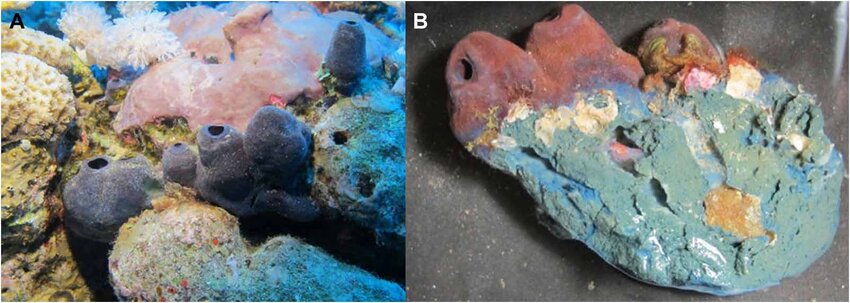
T. conica from the Red Sea. (A) the sponge seen in the Gulf of Aqaba at 30 m in depth before sampling. (B) image showing the sponge’s external maroon (ectosome) and interior blue (endosome) parts following sample removal.
In a fascinating real-life discovery, scientists in the Red Sea have uncovered that sea sponges utilize shiny metal to defend against predators.
Research conducted in the Gulf of Eilat on the Red Sea revealed that sponges have developed a unique method to deter predators. The study identified a significant concentration of the highly toxic mineral molybdenum (Mo) in these sponges. Furthermore, researchers pinpointed the bacterium responsible for enabling sponges to store such high quantities of this precious metal and delved into the symbiotic relationship between the two organisms.
The study, spearheaded by PhD student Shani Shoham and Prof. Micha Ilan from TAU’s School of Zoology, was published in the prestigious journal Science Advances.
Sponges, being amongst the earliest multicellular organisms, inhabit marine environments and play a crucial role in the planet’s carbon, nitrogen, and silicon cycles. With the capacity to filter seawater 50,000 times its body weight each day, sponges can accumulate various trace elements. Scientists are particularly interested in understanding how they handle toxic substances like arsenic and molybdenum, given the massive amounts of water that flow through them daily.
A few decades ago, researchers discovered high concentrations of molybdenum in a rare sponge species known as Theonella conica from the coral reef of Zanzibar in the Indian Ocean. Molybdenum, a trace element essential for cellular metabolism in all animals, including humans, is widely utilized in various industries.
PhD student Shani Shoham explains, “In my research, I sought to investigate if similar high concentrations of molybdenum could be found in this sponge species in the Gulf of Eilat, where it thrives at depths exceeding 27 meters. Analysis of the sponge revealed an unparalleled molybdenum content, exceeding that of any other organism on the planet: 46,793 micrograms per gram of dry weight.”
She adds, “Molybdenum, like other trace elements, becomes toxic at concentrations surpassing its solubility in water. However, we must consider that a sponge is essentially a mass of cells without organs or tissues. In the case of Theonella conica, up to 40% of the body volume comprises a microbial community – bacteria, viruses, and fungi living symbiotically with the sponge.
One predominant bacterium, known as Entotheonella sp., acts as a ‘detox organ’ by storing metals within the sponge’s body. By accumulating increasing amounts of molybdenum, the bacteria transform it from a toxic soluble state into a mineral. While the reasons behind this behavior are not fully understood, it is suggested that the molybdenum serves as a protective mechanism, signaling the sponge’s toxicity to predators. In return for this service, the sponge provides a host for the bacteria and refrains from consuming them.”
No Sponge Farming for Rare Metals
Although molybdenum is highly sought after, primarily for alloy production (such as high-strength steel), extracting it from sponges is deemed impractical. Shoham notes, “While the concentration is substantial, the actual weight of molybdenum obtained from each sponge would be minimal, considering the relative scarcity of the sponge.
“Sponge cultivation in marine settings, primarily for pharmaceutical purposes, poses significant challenges. Sponges are delicate creatures that require specific conditions to thrive.
“Future research should focus on the metal-accumulating capabilities of Entotheonella sp. bacteria. Our lab previously identified significant concentrations of other toxic metals, arsenic (As) and barium (Ba), in a closely related species, Theonella swinhoei, commonly found in the Gulf of Eilat.
“Once again, Entotheonella was found to be responsible for storing these metals and converting them into minerals, thus neutralizing their toxicity. Further research on these bacteria could prove valuable in treating water sources contaminated with arsenic, a major threat affecting the health of millions worldwide.”






